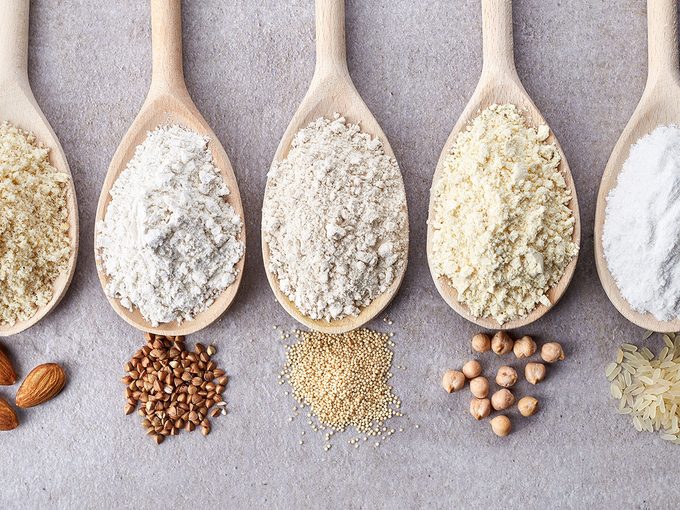Healthy Flours to Bake With Now

A registered dietician and recipe developer shares why you should be cooking and baking with whole wheat, spelt, almond, coconut, and other healthy flours.
Registered Dietitian and blogger behind The Full Helping, Gena Hamshaw has taken all our favourite baked goodies and made them healthier. Her secret? She uses nutrient-packed flours. Hamshaw makes Vegan Pumpkin Cranberry Walnut Muffins with whole wheat flour, Grain Free Vegan Coconut Pistachio Lemon Cake with coconut and almond flour, and Sweet Cherry Oat Crumble Bars with light spelt flour. And it’s not just the flour that’s healthy—all her treats are loaded with nutritious ingredients like fruits, veggies, and nuts.
Here, we asked Hamshaw to debunk the myths around white flour, tell us why we should experiment with new flours, and share tips for healthy baking with alternative flours.
Why and when did you start experimenting with different flours?
I’ve always loved different whole grains and types of wheat. I appreciate the depth of flavour and nutty flavour, not to mention the nutritional enrichment, that whole grains and ancient grains add to baking. I’ve used different flours for as long as I’ve been baking (a decade now!), but I’ve become more skilled with them in the last five years, as I learn more about the science of baking and how different flours work.
Is white flour that bad for you?
My perspective as a dietitian is that white flour isn’t “bad.” Like most foods, it can have a healthful place within the context of a balanced diet. White flour is the best choice for certain types of baked goods and breads, and it’s not necessary to eliminate it. Rather, you can enjoy it where it does the job best while also taking the time to get to know different flours in recipes where they can shine!
When is white flour not the best flour option for baking?
The limitation of white flour is that it’s less rich in fibre than other types of flours. If your goal is to eat more fibre (which is associated with fullness, digestive health, and heart health), then it’s helpful to add whole grain and ancient grain flours to your baking rotation. (Here’s why you might want to increase your fibre intake.)
Is there such a thing as a “healthy” flour?
Certainly! Whole wheat and ancient wheat flours have micronutrients, protein, and fibre. Even white flour has protein, albeit with fewer micronutrients than whole wheat flour. And ancient grain flours also contain different minerals and micronutrients. (Ancient grains is one of the foods that’ll improve your overall health.)
What are the “healthiest” flours available?
Whole wheat and ancient wheat flours, such as spelt, rye, einkorn, and regular whole wheat, offer the most bang for your buck in terms of fibre, protein, and micronutrients. I especially appreciate sprouted grain flours because their nutrients are made more bioavailable through the sprouting process! Sprouted wheat flour is one of my go-to flours for bread and homemade baked goods. Gluten-free flours, like millet, brown rice, and corn, are the healthiest option for those with celiac disease or gluten sensitivity.

What do you need to know about cooking and baking with different flours? Can you swap white flour in any recipe with an alternative?
It’s really important to understand that you can’t just trade one flour for another in baking recipes—especially if there’s a difference in gluten content. Whole wheat and white flours work differently, as do flours that contain gluten and those that don’t. Ancient grain, whole grain, and gluten-free flours offer up wonderful possibilities for the home baker, but you need to study how they work in baking in order to confidently make replacements or swaps. I usually recommend trading a small portion of regular wheat flour with an alternative in a baking recipe (for example, replacing one quarter of the white flour with a whole grain alternative) and seeing how the results are before you try a 1:1 swap.
What are your favourite flours?
Sprouted whole wheat, red fife, rye, and spelt flour from One Degree Organics. Einkorn flour is a nice option, too. For gluten-free clients and friends, I like One Degree’s sprouted brown rice flour, along with sorghum and millet flours (which are sweet tasting and fun to work with).
What is your favourite dish to make with each of your favourite flours?
I make homemade breads with rye, spelt, wheat, and whole wheat flours. For quickbreads, like banana bread or breakfast muffins, I usually use a combination of regular wheat flour and whole grain varieties. When I’m baking for friends or clients with gluten allergies, I make homemade gluten-free blends with brown rice flour, sorghum or millet flour, and potato or tapioca starch.
What holiday treats can be made with healthy flours?
I love to make wholesome muffins and cookies with whole grain and sprouted grain flours! One of my favorite sweet snacks is a banana chocolate chip oatmeal cookie that I make with oats and sprouted wheat flour. It’s energizing and delicious, but it’s got more fibre and nutrition than a lot of other holiday treats. I also enjoy making tea cakes and breakfast muffins to give to friends at this time of year, and I usually opt for a blend of regular and whole wheat flours for those.
Where do you shop for flours?
A lot of whole grain flours can be found in mainstream grocery stores. But it’s worth hunting down sprouted grain or ancient wheat flours if you can find them. One Degree Organics‘ sprouted flours, for example, can be found at many natural retailers throughout Canada and the U.S., usually along with a selection of gluten-free flours and other special baking options. If you can’t find sprouted or whole grain flours near you, you can try shopping online for freshly milled flours, too.
Now that you’ve learned about healthy flours, read the tips you need to know for baking a gluten-free pie.




